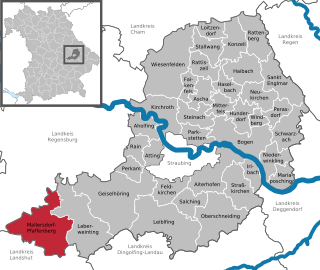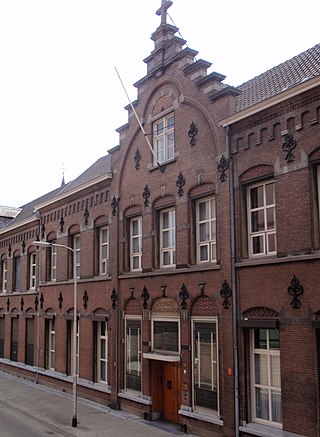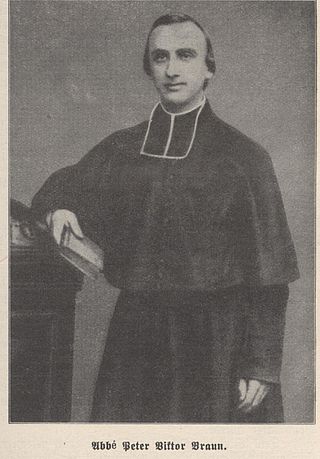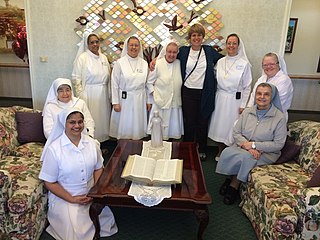Related Research Articles
The Franciscan Sisters of Christian Charity are a Congregation of Roman Catholic apostolic religious women. The congregation was founded in 1869 in Manitowoc, Wisconsin in the Roman Catholic Archdiocese of Milwaukee, later part of the Roman Catholic Diocese of Green Bay. The sisters have active apostolates in education, health care, spiritual direction, and other community ministries. As of 2021, there are 188 sisters in the community. The FSCC is a member of the Council of Major Superiors of Women Religious, an organization which represents women religious in the United States.
The Poor Handmaids of Jesus Christ (PHJC) is a female congregation of the Catholic Church. It originated in Dernbach (Westerwald), Germany, where the generalate is still located. Their organization for associates is also open to men. The Poor Handmaids of Jesus Christ American Province has its motherhouse in Donaldson, Indiana.
The Franciscan Sisters of Mary is a Roman Catholic religious congregation of religious sisters based in St. Louis, Missouri, noted for its operation of SSM Health Care, a group of some 20 hospitals throughout the Midwestern United States. It was formed in 1987 from the merger of two related congregations that founded many of the hospitals.
The Third Order of Saint Francis is a third order in the Franciscan tradition of Christianity, founded by the medieval Italian Catholic friar Francis of Assisi.
Mary Odilia Berger, S.S.M. was a German-born Catholic religious sister who founded the Sisters of St. Mary in 1872 in St. Louis, Missouri. The order established and still runs hospitals throughout the Midwestern United States. In 1987 they merged with Sisters of St. Francis of Maryville, another congregation which had branched off from them, and together became the Franciscan Sisters of Mary.

Brother James Wirth, F.F.S.C., was a German Catholic Religious Brother who founded the religious congregation of the Franciscan Brothers of the Holy Cross. They are dedicated to the care of disadvantaged youth, especially orphans, primarily through providing vocational training to help them lead successful lives as adults.
The Franciscan Apostolic Sisters (F.A.S.) is a Roman Catholic religious congregation that was founded in the Philippines in 1953 by Gerardo Z. Filippeto. Filippeto was a missionary in the remote northeastern region of the nation. He founded this congregation of Franciscan tertiary sisters to help in the work of the missions and spreading the Gospel in that region.

Mallersdorf-Pfaffenberg is a municipality in the district of Straubing-Bogen in Bavaria, Germany and has around 7,000 inhabitants.
The Sisters of the Sacred Hearts of Jesus and Mary (SS.H.J.M.) are a group of Catholic Religious Sisters who were established in London, England, in 1903. There they are commonly known as the Chigwell Sisters. In collaboration with their associates, auxiliaries, co-workers and volunteers, the Sisters work with the poor of the world, both to identify and transform underlying causes of suffering and to meet their practical needs. However, the order has been involved in controversies that exploited such poverty, such as forced adoptions and "Mother and Baby" homes.

Paul Joseph Nardini, was a German diocesan priest and the founder of the religious congregation of the Poor Franciscan Sisters of the Holy Family, also commonly known as the Nardini Sisters, or the Mallersdorfer Sisters from the town where they are now headquartered. He was beatified in 2006 by the Catholic Church. He is commemorated on 27 January.
The Sisters of Saint Elizabeth are a Roman Catholic religious institute. Generally styled "Grey Nuns".
The Franciscan Sisters of the Poor are a religious congregation which was established in 1959 as an independent branch from the Congregation of the Poor Sisters of St. Francis, founded in Germany by Blessed Frances Schervier in 1845.

The Sisters of Charity of Our Lady Mother of Mercy (SCMM) are a Catholic religious congregation founded in the Netherlands in 1832 by Fr Johannes Zwijsen, aided by Mary M. Leijsen, for the instruction of children and the betterment of people deprived of spiritual aid. The motherhouse is in Tilburg.
The Franciscan Brothers of the Holy Cross are a congregation of Religious Brothers of the Franciscan Third Order Regular who were founded by Brother James Wirth in Hausen, Germany, on 12 June 1862. They were founded to answer a call to care for orphans, the poor, the sick and the suffering.
The Sisters Servants of the Sacred Heart are a French religious congregation founded in 1866. They currently serve throughout France and Africa. According to their current Superior General, Sister Danièle, their service consists of "serving the Sacred Heart of Jesus through responding to the needs of world wherever they find themselves."

The Servant of God, Abbé Pierre-Victor Braun, was a French Catholic priest who ministered to the poor of Paris. His work laid the foundations for the establishment of several different congregations of Religious Sisters who now serve worldwide. The cause for his canonization was opened in France in 1991, and was accepted for investigation by the Holy See in 2007.
The congregation of the Franciscan Sisters of Allegany, with its motherhouse at St. Elizabeth's Motherhouse, Allegany, New York, was founded in 1859 by the Very Rev. Father Pamfilo of Magliano, O.F.M.

The Franciscan Hospitaller Sisters of the Immaculate Conception are members of a Roman Catholic religious institute of consecrated women, which was founded in Portugal in 1871. They follow the Rule of the Third Order Regular of St. Francis. and, as the term “hospitaller” indicates, focus their ministries on a spirit of medical care. Their charism emphasizes hospitality and service under the model of the Good Samaritan. In this congregation, the postnominal initials used after each sister's name is "F.H.I.C."
The Sisters of St. Francis of the Neumann Communities was formed in 2004 with the union of three separate congregations: Sisters of St Francis of Syracuse, Sisters of St. Francis of the Mission of the Immaculate Virgin, and the Sisters of St. Francis Third Order Regular of Buffalo. During the process of the reorganization, the Franciscan Missionary Sisters of the Divine Child merged with the Williamsville Franciscans in 2003. The Sisters of St. Francis of Millvale merged with the congregation in 2007.
References
- 1 2 3 4 "Paul Joseph Nardini (1821-1862)", Vatican News Services
- ↑ "Father Paul Joseph Nardini", Franciscan Nardini Sisters of the Holy Family
- ↑ "Dr. Paul Joseph Nardini"
- ↑ Mallersdorf Sisters "Gründer" (in German) Archived 2012-02-12 at the Wayback Machine
- ↑ Mallersdorfer Sisters "Unsere Einsatzorte: Rumänien" (in German)
- ↑ "Called to serve in South Africa", Franciscan Nardini Sisters of the Holy Family